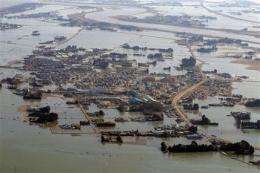Japan quake loaded stress on fault closer to Tokyo

The recent monster quake that hit northeastern Japan altered the earth's surface, geologists say, loading stress onto a different segment of the fault line much closer to Tokyo.
Experts are quick to point out that this doesn't mean a powerful earthquake is necessarily about to strike the Japanese capital. Even if it did, the structure of the tectonic plates and fault lines around the city makes it unlikely that Tokyo would be hit by a quake anywhere near the intensity of the 9.0-magnitude one that struck March 11, said Roger Musson of the British Geological Survey
But, given the vast population - Tokyo and its surroundings are home to 39 million people - any strong temblor could be devastating.
"Even if you've got, let's say, a 7.5, that would be serious," the seismologist said.
Japan is located on the Ring of Fire, an arc of volcanos and fault lines spanning the Pacific Basin, and is regularly hit by earthquakes.
But before last week's quake - the largest to hit the country since it started keeping records 130 years ago - few geologists considered Japan to be a strong candidate for a 9-plus earthquake, said Andrew Moore, of Earlham College in Richmond, Indiana.
There is mounting evidence, however, that Japan has been struck by several severe quakes in the last 3,500 years - most in the northern reaches of the country. Sand deposits indicate that several quakes have spawned 30-foot-high (9-meter-high) waves that slammed into the northern island of Hokkaido, he said, the most recent in the 17th century.
Similar deposits underlie the city of Sendai - the area rocked last week - with the most recent from an 869 A.D. tsunami that killed 1,000 people and washed more than 2.5 miles (three kilometers) inland.
And even weaker quakes that hit Tokyo in the past have caused significant damage.
But last week's tremor changed the coastal landscape - and not just above sea-level. It created a trench in the sea floor 240 miles long (380 kilometers long) and 120 miles wide (190 kilometers wide) as one tectonic plate dove 30 feet (nine meters) beneath another, said Eric Fielding of NASA's Jet Propulsion Laboratory.
While that relieved stress at the breaking point, it appears to have piled pressure onto adjacent segments, said Brian Atwater, a geologist with the U.S. Geological Survey.
That added strain could now trigger a strong, deadly aftershock on Tokyo's doorstep.
It's a common occurrence after strong quakes and happened after the 2004 mega-earthquake and tsunami off Indonesia that killed 230,000 people in a dozen nations.
Three months later, an 8.6-magnitude quake erupted farther down the fault line, killing 1,000 people on sparsely populated Nias island.
"But it's difficult to say," said Atwater. "There are good examples of such stresses leading to other earthquakes, big earthquakes, and there are good examples of that not happening."
Scientists are studying the March 11 quake and ongoing seismic activity to determine where new strains might be building.
"When the main shock is this big, you get a football-shaped region where aftershocks are fair game. It extends in all directions," including toward Tokyo, USGS seismologist Susan Hough and other experts said.
But, they acknowledge, it's hard to keep up.
"We are drinking from a fire hose here. The input data keeps changing and augmenting," Ross Stein, of the USGS, wrote in an e-mail.
His focus now is on the fragment of the Pacific tectonic plate lodged beneath Tokyo - movement of which is believed to have caused a 7.3-magnitude quake in 1855 that killed an estimated 7,000 people.
"We believe ... the faults which bound the fragment were brought closer to failure by the magnitude-9 quake," Ross said.
©2010 The Associated Press. All rights reserved. This material may not be published, broadcast, rewritten or redistributed.


















